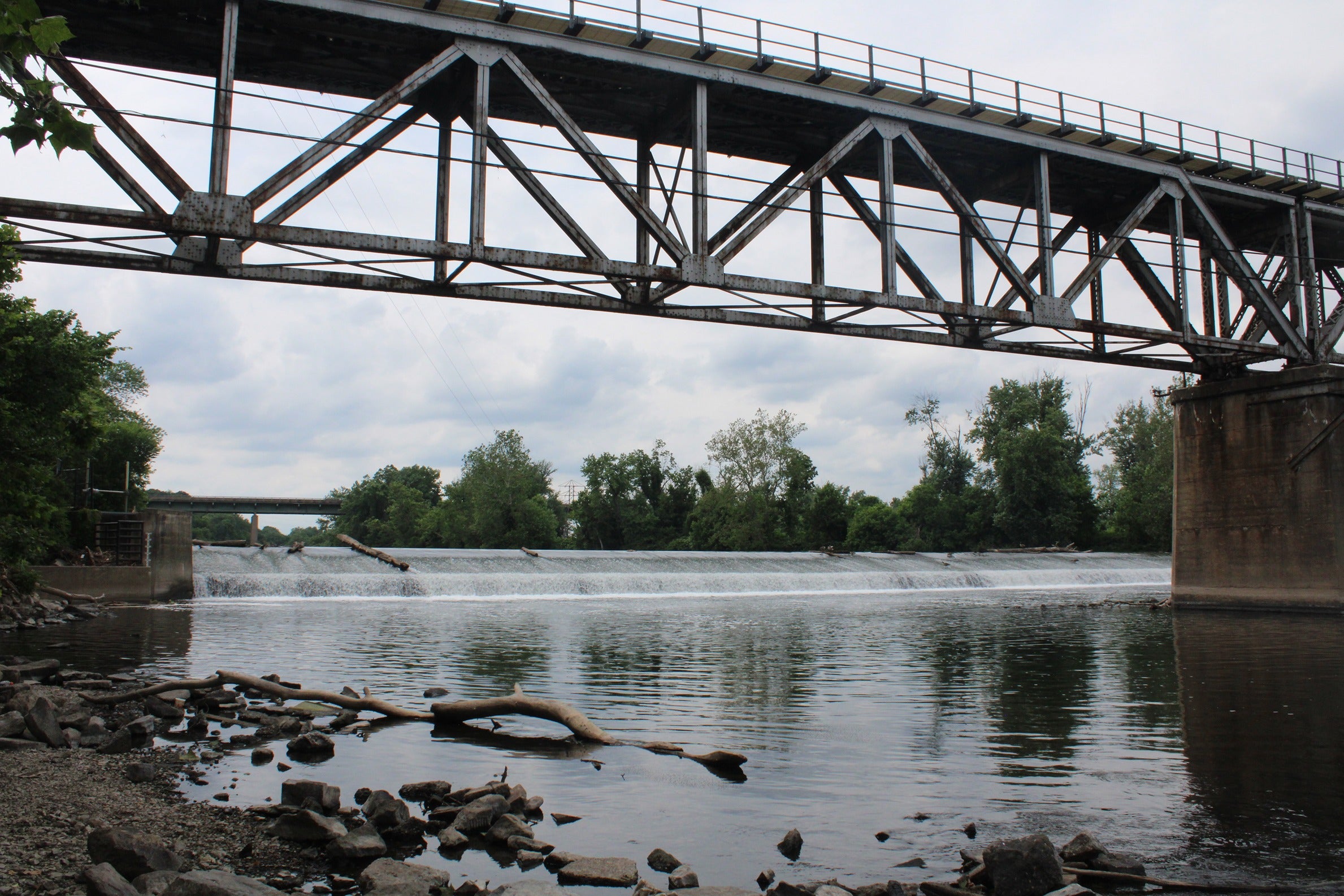Montco officials say an unused dam along the Schuylkill in Norristown could provide green energy for the county
The dam could generate enough electricity to power all county operations in Norristown.
Listen 1:00
Montgomery County is exploring a plan to use the Norristown Dam on the Schuylkill River to generate hydropower. (Emily Neil/WHYY)
This story is part of the WHYY News Climate Desk, bringing you news and solutions for our changing region.
From the Poconos to the Jersey Shore to the mouth of the Delaware Bay, what do you want to know about climate change? What would you like us to cover? Get in touch.
Montgomery County took a step toward creating its own source of renewable energy Wednesday as officials hosted a public meeting on a potential project to use the Norristown Dam to generate hydroelectric power.
The county is currently seeking federal approval for the project. Officials recently submitted an Initial Consultation Document to the Federal Energy Regulatory Commission (FERC) to start what will be a 2–5 year process. Wednesday’s public meeting was a part of that process.
The hydroelectric project would generate an estimated 7,300 MWh annually, according to the project proposal. That would be more than enough to power One Montgomery Plaza and the new Justice Center in Norristown, which have an estimated yearly power demand of 3,600 MWh.

The project has been years in the making, officials said. Montgomery County took ownership of the Norristown Dam from PECO in the 1990s — the dam was originally built in the early nineteenth century as part of the Schuylkill Navigation System to open up the river as a commercial waterway, primarily to transport anthracite coal.
A fish ladder was installed for migrating American shad in 2008, and in 2016 the county began exploring options for using the dam to generate hydroelectric power. A 2023 feasibility study indicated that recent improvements in hydropower technology made the project more financially viable.

County Commissioners Tom DiBello and Neil Makhija, along with members of the Montgomery County Planning Commission and consulting firm Verdantas, presented the current project proposal and responded to public comment at Bridgeport Borough Hall. Meeting attendees took a tour of the proposed dam site afterwards.
Commissioner Makhija said the project is key to achieving the county’s climate action goals, which include using 100% renewable energy for all county operations by 2050.
“We needed to get to net zero carbon emissions by 20 years ago,” Makhija said. “And the idea is that we are already behind in terms of our targets on reaching renewable energy with net zero carbon emissions. So we have to take every step we can within our power to take climate action now. And for us, that means at the local level, taking use of a county-owned property like this dam and harnessing it for renewable energy in the form of hydroelectric power.”
Public comments at the meeting were overall supportive of the project, although people expressed questions about how the power will be distributed and used, as well as concerns about impacts on fish and aquatic life, flood levels in Bridgeport and how it would affect kayakers and recreation in that area of the Schuylkill River. Verdantas representatives working on the project said all of those factors have been or will be studied and explored in the federal permitting process.
Community members can also submit comments directly to FERC, using the project’s number of P-15347. All comments and study requests have to be submitted by Aug. 4.
The current plan proposes a submerged unit on the Bridgeport side of the River, with a small onshore control unit that would be about the size of a shipping container.

Saba Al-Zaid, Bridgeport Borough Council president, said she’s advocating for Bridgeport residents in the process and “happy they’re bringing it to the community and we’re getting to ask the questions.”
“Ultimately, you know, this is a neighborhood and a town that’s really affected by global warming, we’ve had a flood here, multiple floods,” Al-Zaid said. “And it’s something that we’re constantly worried about. Bridgeport actually created a public safety committee just to kind of combat that.”
She said it’s important for the town to both prepare for increased flooding and do its part to cut carbon emissions.
Climate scientists say the region will experience more precipitation due to climate change, which will result in more flooding.
Zach Davis, chair of the Upper Merion Township Environmental Advisory Council, attended the meeting. He said he’s “excited” about the project, and hopes the plan considers the use of microgrids to distribute power.
“I think it is the morally right thing to do. I think it’s fiscally responsible. It allows us to rely less on the grid and more on our own natural resources, being the Schuylkill River. And I think this is just an easy way to have clean, renewable energy in our community,” Davis said.
Commissioner DiBello supports the project, but said he is focused on ensuring it’s financially feasible. So far, he said the numbers are indicating that long-term, the hydroelectric project could result in an overall cost reduction for county operations, which in turn would provide greater value to taxpayer dollars.
“If we can make this, from a feasibility standpoint, to utilize the water, the river to generate and offset power that’s going into the grid or power that we could potentially use at the courthouse or in Norristown itself, I think that’s a benefit for everyone,” he said.
Project updates and next steps will be published online at the county’s website.

Get daily updates from WHYY News!
WHYY is your source for fact-based, in-depth journalism and information. As a nonprofit organization, we rely on financial support from readers like you. Please give today.






